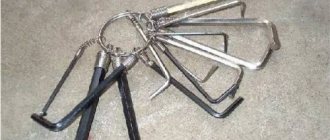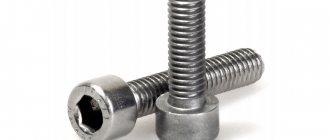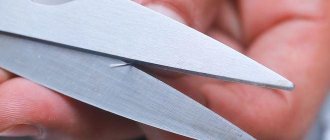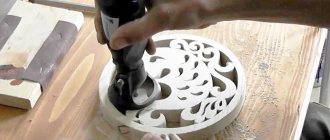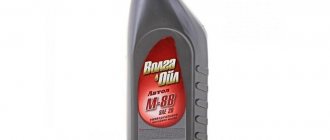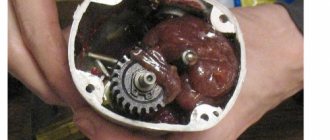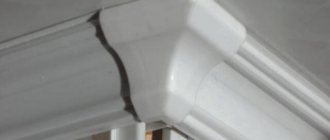How to replace a protractor
A protractor at home can be replaced with:
| How can you replace a protractor? | Description |
| Paper | Ideal for determining angles of 30, 45, 60 degrees. The leaf has all angles of 90 degrees; if you fold it in half, you get 45. If you divide it into three parts, you get 30 and 60 degrees. |
Accordingly, if you fold 30 in half, you get 15 degrees. You can also get an angle of 180 degrees. In other cases, you will have to use a protractor.
Quite often, people have a question about what can replace a protractor at home, since it is not always at hand.
There are several alternatives that allow you to make calculations, however, you need to keep in mind that all methods may have errors, so it is better to use a protractor.
Sturdy specimen
Products made of ceramics and plasticine are fragile and short-lived. For this reason, it is better to choose other substances. For example, if it is necessary to make an “eternal” vibrator, what can the body be made of? An excellent option is wood. It is possible to cut a penis of any size from it.
It is important to thoroughly polish the workpiece with sandpaper to remove splinters. Don't forget to make a place inside for the motor and batteries. Afterwards the product can be painted or varnished. The opening for the elements can be covered with sealant. What else could an electric vibrator be, and how can it replace wood? The solution is simple: with various strong substances - clay or alloy.
A more difficult option is to select some materials and make a store-bought sample. For example, a watery polymer can be used. It is used to build swimming pools. As a mold, you should use a condom, a flexible or iron pipe, a hose, etc. The motor can be removed from an old toy. It must be placed inside the “mold” together with the batteries and filled with silicone. All that remains is to wait for the substance to dry, and the accessory can be used with confidence.
Checked leaf
On a checkered piece of paper you can easily take measurements of the same standard angles as in the previous version.
- Determining 90 degrees will be easiest - you just need to draw a square.
- By drawing a diagonal in the square you can get an angle of 45 degrees.
- To determine 30, 60 degrees you need to draw a rectangle (5 cells in length, 3 in height). Drawing a diagonal in it, we get an angle of 30 and 60 degrees. If we divide an angle of 30 into 2 parts with a line, we get 15 degrees.
The resulting angles must be cut out and compared with the given angle. Usually, after applying the blanks, it is possible to visually determine the approximate indicators.
Penis with zucchini and peas
For the base, you should find a slightly unripe zucchini of the required shape and volume in the garden bed. The top must be trimmed, the pulp of the vegetable must be carefully removed and the inside of the hollow fruit generously anointed with sunflower oil. This is the shape of the upcoming toy.
Stage two is to make the device itself. Mix whole dried peas and PVA glue in a cup, insert a condom into the zucchini and fill with the mixture. After it has hardened, cut the vegetable and enjoy the wavy toy by putting a condom on it.
Mechanical watches
A watch dial would be a great alternative to a protractor. It is possible that such measurements will have a slight error, so it is better to use it only for home purposes, and not to make any serious measurements.
The clock has 60 identical divisions, each equal to 6 degrees. Accordingly, half a division is 3 degrees, and 1/3 is equal to two.
If you manage to place the watch exactly at the point where the angle begins, the error will be insignificant.
Finding the perfect alternative to a protractor is quite difficult, but nothing is impossible. Therefore, you can use simple recommendations that will help you determine the required angle.
But you need to keep in mind that each method has its own characteristics and will not always help you find out the exact numbers. The simplest replacement for a protractor is a prepared paper stencil, but it is not always possible to print it.
Source
To take measurements
In order for the floor covering to be smooth and last a long time, you will need a tool to take measurements and markings. The master needs to have on hand:
- Roulette. This useful household device will be required often when laying laminate flooring. Even before work begins, you will need to take measurements of the rooms in order to know how much material you will need to buy.
- Meter ruler made of metal. If a tape measure is convenient for taking measurements of large-scale objects, then for measuring small parts and drawing straight lines you cannot do without a ruler.
- Metal square. Necessary for laying right angles.
- Protractor. This measuring tool is needed if you plan to lay the laminate flooring diagonally or shaped. In this case, it will be possible to cut the lamellas not only at a right angle, but also at an acute angle.
Advice! Instead of a protractor, you can use a device for a similar purpose - a protractor.
- Pencil. The purpose of this device does not need to be explained to anyone; it is necessary for applying marks.
How to make a protractor with your own hands from paper
A protractor at home can be replaced with:
| How can you replace a protractor? | Description |
| Paper | Ideal for determining angles of 30, 45, 60 degrees. The leaf has all angles of 90 degrees; if you fold it in half, you get 45. If you divide it into three parts, you get 30 and 60 degrees. |
Accordingly, if you fold 30 in half, you get 15 degrees. You can also get an angle of 180 degrees. In other cases, you will have to use a protractor.
Quite often, people have a question about what can replace a protractor at home, since it is not always at hand.
There are several alternatives that allow you to make calculations, however, you need to keep in mind that all methods may have errors, so it is better to use a protractor.
Creating a Swenson Square
The author of such a useful device did not have time to properly file a patent for his brainchild, and numerous businessmen are actively using this.
The only thing they can't use is the special diamond cut hole, but some very resourceful competitors make a slightly different shaped slot. In the initial version, the Svenson square did not have a comb for special parallel markings and the hole itself. However, the comb is not an option that you cannot do without. It must be said that in almost a hundred years of history the device has not undergone significant changes.
Checked leaf
On a checkered piece of paper you can easily take measurements of the same standard angles as in the previous version.
- Determining 90 degrees will be easiest - you just need to draw a square.
- By drawing a diagonal in the square you can get an angle of 45 degrees.
- To determine 30, 60 degrees you need to draw a rectangle (5 cells in length, 3 in height). Drawing a diagonal in it, we get an angle of 30 and 60 degrees. If we divide an angle of 30 into 2 parts with a line, we get 15 degrees.
The resulting angles must be cut out and compared with the given angle. Usually, after applying the blanks, it is possible to visually determine the approximate indicators.
How to combine several of your orders into one?
Open the desired order. In the order control panel, click the “add to cart” button. Then click the “archive” button or the “cancel order” button - so that there is no confusion. That. you can transfer the contents of all your orders to the basket, and then opening the last order, add the entire contents of the basket to it, as described in the previous paragraph. If, in the process of combining several orders into one, you need to add something from the site catalog itself, then you can also add the necessary products to the cart or remove unnecessary items from the cart and then transfer the contents of the cart to the desired order. IMPORTANT. This operation is available for orders with the “preliminary” category. If the order category is different, then this operation is not available!
Mechanical watches
A watch dial would be a great alternative to a protractor. It is possible that such measurements will have a slight error, so it is better to use it only for home purposes, and not to make any serious measurements.
The clock has 60 identical divisions, each equal to 6 degrees. Accordingly, half a division is 3 degrees, and 1/3 is equal to two.
If you manage to place the watch exactly at the point where the angle begins, the error will be insignificant.
Finding the perfect alternative to a protractor is quite difficult, but nothing is impossible. Therefore, you can use simple recommendations that will help you determine the required angle.
But you need to keep in mind that each method has its own characteristics and will not always help you find out the exact numbers. The simplest replacement for a protractor is a prepared paper stencil, but it is not always possible to print it.
A protractor is a tool that is used in constructing and measuring precise degrees of angles in the mathematical sciences. It is quite difficult to purchase at an office supply store as they are rarely in stock. If you have a printer in your home arsenal, then making such a tool will not be difficult; to do this, it will be enough to print out any sample and stick it on thick paper or stationery cardboard.
Protractor Printing Programs
Very often, when working with iron, especially machine and automotive iron, angle measurements are required. When it’s static, you can use a protractor, but if it’s dynamic, such as when calibrating the SPD regulator? For such purposes, at that time, two protractor printing programs were written: one prints a tape scale for sticking on the shaft, the second prints a circular scale for sticking on the end. They have some glitches with formatting after printing, but it’s lazy to rewrite, and you can restart these programs:
linear protractor (7.4 KiB, 12,622 hits) round protractor (7.9 KiB, 14,795 hits)
Requires Vb6 runtime, license - WTFPL version 2.
If you liked the program so much that you suddenly wanted to support the author, this can be done easily!
No similar entries found.
Homemade protractor from a smartphone
And everything would be fine, but the toad somehow suffocates me, and the itching in my hands gives me no rest.
An inner voice tells me that the sensor (accelerometer) in a modern smartphone should be very accurate and, probably, the smartphone could compete with ready-made devices in determining the angle of inclination. Based on these considerations, I came up with the idea of making a platform for installing a smartphone and using this “hodgepodge” as a protractor. And, of course, check whether this solution works. What do I have to achieve my plans? The set is simple. 1. Screws with inch threads, these are used for fastening mounts to cameras, for example. I bought it here for 181 rubles/pair ru.aliexpress.com/item/2pcs-High-Quality-Female-Silver-1-4-D-ring-Screw-Convert-Stainless-Steel-For-Tripod… 2. Smartphone mount for mounting on a tripod. I bought it here ru.aliexpress.com/item/Cell-Phone-Holder-mount-bracket-Adapter-Clip-For... And I got it as a gift from my good friend (Seryozha, thank you!) 3. A piece of duralumin plate 16 mm thick 4. And a calibration square of the 1st accuracy class. It will be needed to assess the quality of determining the angle of inclination. That's all. The rest is pure enthusiasm and good mood. Go! I deviated a little from tradition and did not make any drawings, I think that if someone wants to repeat it, they will take it and repeat it, based on the available materials. I’ll describe it in words - I want to make a block from a duralumin plate, in which there will be a hole for screwing in a smartphone mount, two holes with M4 threads for installing adjusting bolts, and holes for magnets in the base of the block (optional). It's simple! Let's start with the markings. Sawing by hand is completely lazy, and why, when you can use a band saw with a blade for sawing soft non-ferrous metals. If anyone is interested, the JET JBS-12 file, I won’t say anything bad about it, I like it, although I have nothing to compare it with, so my sympathies are completely biased. The cut after sawing remains imperfect and not very even, primarily because I sawed without guides. I'll have to make it beautiful on my homemade CNC milling machine. Although, of course, this is not necessary - just aesthetics. I walked along all the side edges and it became really good! A piece of wood (amaranth is a very beautiful natural color of wood, potassium lilac), left over from the crafts, I used it as a support base, having previously leveled the edge. After that I start working on the holes. As you understand, I didn’t do them manually either. First I made the top part. And then the bottom one, choosing the recesses for the screw head and magnets. I’ll say right away that I haven’t glued them in yet, I don’t have them in stock, the order hasn’t arrived yet. After rough preparation of the base block, it’s time to move on to finishing work. I will cut an M4 thread for the adjusting bolts. And now you can show the almost finished “explosion diagram”. I had to tear off the handle of the screw with an inch thread; it dangles and is a little annoying, and to be completely honest, it just infuriates)). I'm putting together a device. The design turned out to be very simple, but at the same time quite neat, at least I’m not at all ashamed of it. We insert my Huawei Honor 5A (aka LYO-L21) into the device. It sat fine, but given that there was only one attachment point, the adjusting bolts came in handy. They act as spacers; they can be tightened if necessary and secure the smartphone. In the photo, I think everything is clear. The bolts, by the way, are still from Soviet stocks, so do not pay attention to their condition. But nothing dangles and the structure is quite stable. The sole of the base is level, I checked it with the flat of a straightening square. For home hobby use, the plane can be called ideal! And now, actually, the experiment itself. For him I will assemble an improvised stand from a vice and a square. I will use Clinometer as the software for determining the angle of inclination, but of course any other convenient one will do. 1. First stage. Huawei Honor 5A. Not cool at all, right? 1.1-1.2 degrees... And this result several times in a row. Let's try another smartphone. 2. Second stage. Huawei Mate 10 is a completely different price category. I hope it has an appropriate accelerometer.
Hmmm... As a result of several “measurements” I got 0.6-0.7 degrees. In short, I screwed up and won’t use my smartphone for accurate measurements. As a result of this experiment, I realized two things: - cheap and expensive smartphones apparently have very low-cost accelerometers that are completely unsuitable for any accurate measurements; — it looks like we need to conduct a similar experiment with a real inclinometer (although to be honest, I believe that inexpensive models have the same budget accelerometer sensors as smartphones, but this is just a guess), although I don’t have one yet.
But Linux lies very smoothly! Just a standard, not a cat! )) This is a bonus for those who were not too lazy to read to the end))
As promised, the video version is attached
Video of making a homemade protractor
Thank you all for your attention! I hope the experiment was not useless for you. See you!
Also see:
Homemade file handle - How to make a file handle with your own hands. Review HUSKVARNA 135 - Chainsaw for the garden. Mini Lathe - Benchtop Size Lathe Review.
All by yourself and with your own hands
Instructions for making a protractor
For this you will need:
Instructions
- You need to make sure that the printer has resolution in all coordinates. Open a graphics editor, draw a square and print it. We take a ruler and double-check all sides of the square, they should be equal. If suddenly it didn’t work out the first time, then print it in a different resolution.
- We scale the saved drawing with the image of a protractor to the size we need in a graphics program, respecting the proportions. If the printer has such a function for printing on film, this is only a plus. Since when working with it, you will be able to see what is underneath it. But if not, then your tool will not be transparent, which is not scary at all, because it will not have any effect on the accuracy of the data.
- Cut out the template along the marked lines. Attach the printed stencil to the org. glass and draw an outline from it.
- Using the resulting silhouette, we cut out the protractor blank using a jigsaw. Unhewn edges should be processed with a file so that they are not sharp. Then we glue the image of a protractor prepared earlier from film or paper to the blank. When using film, it is better to use transparent glue.
- After the glue has dried, drill a small hole. It is located strictly in the center, the diameter of which is 2 mm. This hole will be for a pencil and is usually indicated by a circle. The instrument has a forward, reverse, and semicircle scale divided by divisions, which is a goniometric scale from 0 to 180°. And when using color printing, a gradation of divisions is noted every 30 degrees, which will greatly facilitate working with it.
Often in carpentry there is a need to measure angles other than 90 degrees. This need also arises in construction, for which a simple tool called a malka was invented. In construction, this tool is used mainly when installing window sills, but not every craftsman knows how to use the tool. The goniometer will also be an indispensable tool for those exceptional cases when it is necessary to level the baseboards on the floor or ceiling.
WHAT TOOL IS NEEDED TO MARK A WOOD
Many woodworking projects require the master woodworker to “oh, “outline” or perform a great variety of similar operations. And yet, many woodworkers never purchase the drafting tools shown here, even though such items can certainly improve the accuracy of your work and make your measuring and marking simple and routine.
Draftsmen rely heavily on these specialized tools to produce high-quality sketches and drawings. In their work it is not enough to be “approximately correct”; it is necessary to be strictly accurate. This is exactly what competent carpenters do.
Mechanical pencil
To achieve accuracy when drawing contours and marking cuts, it is necessary to draw thin and stable lines, achievable only with a mechanical pencil.
Plastic eraser
Not all erasers are created equal. Plastic erasers won't damage paper or leave shaggy or fuzzy lines. On wood, they are embedded in the wood tissue and leave no traces or rubber residues.
Create smooth curves for jigsaw cutting with these drafting tools.
French patterns
These clever tools contain almost all the curved lines and line segments you'll need when transferring a drawing or design onto a marking grid. Simply transfer the intersection points of the pattern with the marking grid onto a larger grid and use a French pattern to connect the resulting points. We could suggest that you purchase three sizes of patterns - Alvin kit 351, 352 and 353, so that you always have a tool on hand that will suit any curvature required.
Adjustable square
Because this variable tool can be adjusted from 0 to 90 degrees, it will save you the expense of purchasing many different triangles while ensuring you get precise, precise angle cuts every time. We liked the Mars Staedtler 6-inch model due to its high quality and convenient size.
I keep it in my shop to adjust my table saw, band saw, radial arm saw, and drill press for precise cutting angles. I never rely solely on the angle marks on the machines themselves or on the scales of certain machines.
The eraser will remove marking lines from the plywood that are too thin to remove with sandpaper.
Circle pattern
How many times have you had to look for a teapot lid in order to draw a circle? Next time, use a circle template in combination with a mechanical pencil to get perfectly even, pre-measured circles. With these two templates you can draw any 50 circles with a diameter from 1.5 to 75 mm. They also make drawing corner fillets a breeze. If you need a fillet with a radius of 25 mm, select a circle with a diameter of 50 mm, insert it into the corner before it touches the sides of two adjacent edges, and trace along the radius.
Protractor
An inexpensive and convenient protractor makes it easy to set a sliding grinder or thicknesser to the desired angle or check other angles. You can also use a protractor to segment a circle by dividing a full circle (360 degrees) into the desired number of slices or segments. For example, to mark the hour markers on your watch dial, divide 360 degrees by 12 and mark the dial every 30 degrees to indicate the time in a circle.
Protractor. Set the adjustable lever on the protractor from 90 to 180 degrees to adjust the angle of the fence on your machine.
Parallel rulers
Marking parallel lines along a straight edge is quite simple, but this device will allow you to also draw parallel curved lines. Simply insert a mechanical pencil into the desired hole and you can draw parallel lines anywhere from 0.05mm to 12mm from any edge.
Three tools that are nice to have on hand
Compass
The Mars Staedtler model we chose can draw circles with a diameter of up to 350 mm. With this compass, you can create a variety of circles of varying sizes and perform even more advanced geometry tasks, such as dividing angles or drawing ellipses.
How to make a protractor
Protractors , unlike rulers, are not always available in office supply stores. If you have a printer, you can make this tool yourself. All you have to do is print out the finished sample, cut it out and stick it on a strong material.
Instructions
1. Make sure that your printer has the same resolution in both coordinates. To do this, draw a square in any graphics editor and print it. Measure the sides of the square with a ruler - the measurement results must be identical. If this is not the case, try printing at a different resolution. If it was not possible to achieve the same resolution, use a different printer. In any case, it is desirable that the printer be color. 2. Download the image shown in the title of the article. Scale it using any graphics program, respecting the proportions, to the desired size. Print out the probability sample on film - then it will be more comfortable to use the protractor, since you will be able to see those lines that are located directly under it. If your printer is not compatible with film, use paper, but then the protractor will turn out opaque. 3. Cut out the printed sample according to the silhouette. Place it on a sheet of plexiglass and transfer the silhouette onto it. If the printout is made on paper, the protractor material may be opaque. 4. Remove the sample from a sheet of hard material, then carefully cut a copy of the sample from it using a jigsaw. After this, be sure to file the edges of the workpiece so that they are not sharp. Glue the sample itself to it. If film was used, the adhesive should be transparent. In any case, it should not form ugly spots. 5. When the glue has dried, drill a hole in the protractor about 2 mm in diameter for a pencil. It should be located strictly in the center - the place of its drilling is indicated on the sample with a circle. The finished tool has two scales - forward and reverse, and if a color printer was used - red divisions every thirty degrees, which makes it easier to use.
An angle is a geometric figure that is formed by two rays - the sides of the angle, emanating from one point - the vertex of the angle. Traditionally, to construct a flat angle in planimetry, a protractor is used, with the help of which you can easily plot an angle with a given degree measure, but what if you don’t have this tool at hand? To construct an angle, you can use trigonometric functions and construct a right - angled triangle .
You will need
- Complete table of tangents, ruler
Instructions
1. Let the task be to construct an angle of some dimension ?. Let us construct a segment AB of arbitrary length. Using the ratio of the legs in a right- angled triangle , it is possible to obtain the side BC of this triangle using the formula BC = AB • tg?, the value of the tangent of the angle is ?
You can find out from the table of tangents. Further from point A you need to lay off a segment of length BC perpendicular to segment AB. 2. By combining points A and C, we obtain an angle of a given value ?, with the vertex at point A. Video on the topic Please note! To construct angles?? ? 90?, need to build an angle??
Application
As already noted, goniometer devices have found their application in almost all sectors, industry, and transport.
In the construction industry, goniometers are used when performing installation work, marking and design work. With its help, they control the installation of building structures that are located at a certain angle relative to each other. Moreover, measurements can be carried out in three planes. In addition to the goniometer, plumb lines and levels are used in construction.
In addition, goniometric tools are used in carpentry, carpentry, and geodesy. Even in medicine, this instrument is used to control joints, spine, etc.
Purpose of the goniometer and main tasks
The tool in question can be found in carpentry shops and workshops, where it is simply impossible to do without a protractor. When finishing premises, this tool is used by specialists who know that without it it is impossible to measure an indirect angle with maximum accuracy.
A mill or protractor is a device that makes it possible to determine and fix oblique angles and transfer them to the required workpiece. In construction, the adjustable bevel is used when installing window slopes, window sills, and door slopes. Not every builder knows why a piece of wood is needed, which was confirmed by experiments conducted among vocational school students with a degree in carpentry.
Goniometers come in metal and wood, and even plastic. Wooden markers are more popular because they do not damage the surface of the products being measured. Metal baits are mainly manufactured with a length of 300 mm and with a built-in digital display. Plastic products are the cheapest, as they are less resistant to physical impact than the first two types.
Such tools are called digital, and they are used mainly by professionals, where maximum accuracy is important when carrying out work. The instruments under consideration, despite the material used to make them, consist of the following elements:
Malka: an indispensable assistant in construction
When performing construction or carpentry work, there is often a need to measure angles. For such purposes, a tool called a malka was invented. In the construction industry, this device allows you to speed up and facilitate the execution of work, ultimately achieving excellent results. We will learn in more detail how to use the small tool correctly, as well as the features of measuring angles.
How to make malka yourself
Malka is such a simple tool that you can make it from scrap materials with your own hands. To make malka at home from materials you will need the following parts:
- A block of quality wood. The block can be divided into two parts or a groove of 2 mm in size can be made in it to the middle of the piece of wood. By the way, the size of the wood may be different, but it is better to make it up to 30 cm. The first part of the tool is a fixed block
- As a moving part, it is better to take an old ruler in which a groove should be made. The length of this groove should be equal to half the size of the ruler itself. Instead of a ruler, you can use a thin board up to 2-3 mm
- To connect these two parts you will need to use a bolt and a thumb. Pre-drilled hole in the block
Everything is quite easy and simple, and the appearance and quality of the final instrument depends more on the skill of the person. The resulting homemade fry will be an indispensable assistant in household use.
Instructions for using the goniometer grinder
Often, when a simple tool falls into the hands of a specialist, the question arises of how to use it correctly. One of these tools is a grinder, which is better known as a protractor or surface planer. The material describes the process of measuring slopes using the instrument in question. But what else can you use such a simple and uncomplicated tool for, which you can make easily and quickly with your own hands.
What a malka is and why a protractor is needed is explained in detail in the material. It remains to understand the potential of the tool and find out what actions this device is capable of. Without exaggeration, the possibilities of the tool can be called limitless, since with the help of the device you can measure any angle and find out its exact values. This can be not only a window slope, but also an arch or greenhouse structure, the manufacture of which is carried out by a specialist.
If you don’t know how to use a protractor correctly, then it’s time to look into this issue in detail. To learn how to work with a small spoon, you need to follow an example. So, recently the issue of insulating the walls of a house with polystyrene foam or expanded polystyrene has become relevant. Why might you need a protractor when working with polystyrene foam? Everything is banally simple. If you need to stick foam plastic on the wall of a house that has a triangular or uneven shape, then in this case you will need to use a small tool. This is not necessary, but it will greatly simplify the work.
- To avoid having to measure the angle of inclination of the wall, you need to take a small piece of wood and apply it with one part to a straight angle, and the other to an indirect one.
- After this, you need to fix the moving part in the installed position by screwing the thumb in the central part of the tool
- Attach the protractor in a fixed form to the foam sheet and make a mark with a pencil or marker
- The radius of the corner is known, so all that remains is to use a rule or level to apply it to the resulting mark and draw it to the edge of the foam sheet
- Pick up a cutting tool for cutting foam plastic, which can be not only a construction knife, but also a metal blade. Few people know, but you can also cut polystyrene foam or polystyrene foam with the attachment of a hair dryer. How to cut a sheet of foam plastic if its thickness is greater than the length of the blade of a construction knife. To do this, you can take a special attachment on a hair dryer and make a cut along the mark
- Now the foam plastic in which the corner is cut can be applied to the wall and make sure that the procedure is performed correctly and with maximum accuracy
This is an example of the use of a screed, but the construction sector is not limited to the use of a screed. The device is also used in furniture making, when an irregularly shaped tabletop is made to order.
Often such a tool must be used when carrying out welding work, for example, when it is necessary to make metal posts for an arch or greenhouse with the same deflection angle. Whenever there is a need to cut an angle of the corresponding degree, you will need to pick up a protractor.
It is always convenient to work with this simple and uncomplicated device. Moreover, you don’t need to buy it, because it’s easy to make it yourself. If you set out to buy a small one, then you don’t need to go to hardware stores for this. For this, there are online stores where you can choose a suitable tool of good quality and at a low price. If you don’t yet know how to use a malka, then it’s time to learn, especially since it’s easy and simple.
As a result, it is important to emphasize such a factor as the effectiveness of the goniometer. Without such a tool, making an accurate measurement of an indirect angle would be very difficult. This would require a protractor, which would calculate the angle and then transfer it to the projected plane or workpiece. The video provides a detailed report on making malka with your own hands.
